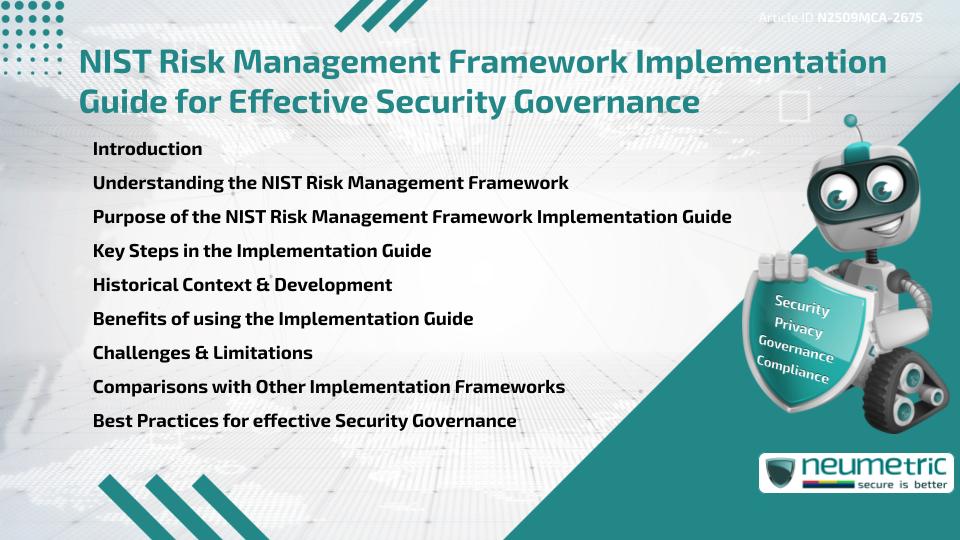Table of Contents
ToggleIntroduction
The NIST Risk Management Framework implementation guide provides Organisations with a structured approach to embedding Security Governance into their IT & Business Operations. It outlines step-by-step actions to identify Risks, select & implement Controls & monitor Systems effectively. This guide is widely used across Industries to strengthen Compliance, improve resilience & ensure Accountability in Security Practices. This article explains the Framework, purpose, steps, benefits, limitations & Best Practices associated with the implementation guide.
Understanding the NIST Risk Management Framework
The National Institute of Standards & Technology [NIST] developed the Risk Management Framework [RMF] to integrate Risk Management practices throughout the System Development Life Cycle. The Framework establishes a repeatable, scalable process for categorising Systems, applying Security Controls, assessing Compliance & ensuring Continuous Monitoring. It is recognised globally as a foundation for robust Security Governance.
Purpose of the NIST Risk Management Framework Implementation Guide
The NIST Risk Management Framework implementation guide serves as a practical roadmap for Organisations. Its purpose is to:
- Translate the RMF into actionable steps
- Help Organisations achieve Regulatory Compliance
- Ensure consistent Governance practices across Systems
- Provide clarity for Risk Management Teams & Auditors
By following the guide, Organisations can adopt a systematic approach to reducing Risks & strengthening their Security Posture.
Key Steps in the Implementation Guide
The implementation guide typically covers these essential steps:
- Categorise Systems: Define impact levels based on Confidentiality, Integrity & Availability.
- Select Security Controls: Choose Controls appropriate for System classification.
- Implement Controls: Deploy Safeguards & Document Procedures.
- Assess Effectiveness: Conduct Independent Assessments to verify Controls.
- Authorise System Operation: Gain approval from Senior Management to accept Risks.
- Monitor Continuously: Track & update Controls to address evolving Threats.
These steps ensure Organisations establish a continuous cycle of Risk Management & Security oversight.
Historical Context & Development
The NIST RMF evolved from the Federal Information Security Management Act [FISMA] of 2002, which required Federal Agencies to adopt standardised security practices. Over time, the RMF expanded to private Organisations & International Users. The implementation guide was introduced to simplify adoption, ensuring that Organisations could navigate the complexities of the Framework with practical Tools & Instructions.
Benefits of using the Implementation Guide
Organisations that adopt the NIST Risk Management Framework implementation guide enjoy several benefits:
- Stronger alignment with Federal Compliance Requirements
- Improved Risk visibility & Accountability
- Reduced Likelihood of Security Incidents
- Clearer Audit trails & simplified inspections
- Enhanced Stakeholder trust & Operational resilience
These benefits make the implementation guide a valuable resource for both Compliance-driven & Security-focused initiatives.
Challenges & Limitations
While the guide provides structure, challenges remain. Smaller Organisations may find the Resource requirements significant, from Staff training to ongoing monitoring. The complexity of Controls & Documentation can also overwhelm inexperienced Teams. Additionally, the structured nature of the guide may limit flexibility for Organisations with unique Operational environments.
Comparisons with Other Implementation Frameworks
The RMF implementation guide is often compared with ISO 27001 & COBIT frameworks. ISO 27001 provides a global Standard for Information Security management Systems [ISMS], while COBIT focuses on IT Governance & Management. The NIST guide, however, offers detailed, step-by-step guidance aligned with U.S. federal standards. Many Organisations adopt a hybrid approach, combining elements of these frameworks for broader Governance & Compliance coverage.
Best Practices for effective Security Governance
To ensure success with the implementation guide, Organisations should:
- Engage Leadership & Stakeholders early
- Provide comprehensive Staff training
- Automate monitoring & Evidence collection
- Regularly update Policies to reflect changes in Risks
- Conduct periodic Internal Audits to maintain readiness
By applying these Best Practices, Organisations can leverage the guide as a tool for Continuous Improvement in Security Governance.
Takeaways
- Provides a structured method for Governance & Compliance
- Resource-intensive but highly beneficial
- Improves Resilience and Regulatory Alignment
- Strengthens Accountability
- Enables long-term Security Governance through Best Practices
FAQ
What is the NIST Risk Management Framework implementation guide?
It is a structured Roadmap for Organisations to apply the RMF, ensuring Compliance & effective Security Governance.
Who should use the implementation guide?
Federal Agencies, Contractors & Private Organisations seeking to align with NIST standards should use the guide.
What are the key steps in the guide?
The steps include Categorisation, Control selection, Implementation, Assessment, Authorisation & Continuous Monitoring.
How does it benefit Organisations?
It improves Risk visibility, ensures Compliance, strengthens Resilience & builds Stakeholder Trust.
What challenges do Organisations face when using the guide?
Challenges include high Resource requirements, complex Documentation & the need for continuous updates.
How does it compare to ISO 27001?
ISO 27001 provides a global ISMS, while the NIST implementation guide focuses on detailed Compliance with U.S. standards.
Can Organisations combine the guide with other frameworks?
Yes, many Organisations integrate it with ISO 27001 or COBIT for comprehensive Security Governance.
Need help for Security, Privacy, Governance & VAPT?
Neumetric provides Organisations the necessary help to achieve their Cybersecurity, Compliance, Governance, Privacy, Certifications & Pentesting needs.
Organisations & Businesses, specifically those which provide SaaS & AI Solutions in the Fintech, BFSI & other regulated sectors, usually need a Cybersecurity Partner for meeting & maintaining the ongoing Security & Privacy needs & requirements of their Enterprise Clients & Privacy conscious Customers.
SOC 2, ISO 27001, ISO 42001, NIST, HIPAA, HECVAT, EU GDPR are some of the Frameworks that are served by Fusion – a SaaS, multimodular, multitenant, centralised, automated, Cybersecurity & Compliance Management system.
Neumetric also provides Expert Services for technical security which covers VAPT for Web Applications, APIs, iOS & Android Mobile Apps, Security Testing for AWS & other Cloud Environments & Cloud Infrastructure & other similar scopes.
Reach out to us by Email or filling out the Contact Form…


